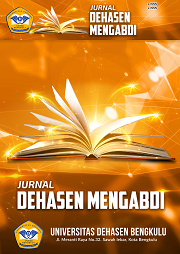Pengabdian Kepada Masyarakat (PKM) Penyuluhan Demam Derdarah Dengue (DBD) Dengan Penerapan 3M Plus Di Dusun 1 Desa Pekik Nyaring Bengkulu Tengah
Abstract
Dengue Hemorrhagic Fever (DHF) occurs due to the bite of the Aedes aegypti mosquito which is often found in countries with tropical climates. The biting activity of Ae. Aegypti which increases during the rainy season can cause an increase in cases of dengue fever sufferers (Dewi and Sudaryono, 2020). Based on data released by the World Health Organization (WHO), around 40% or 2.5 billion of the world's population, both in sub-tropical and tropical countries, are at high risk of contracting the dengue virus. The aim of this community service is to achieve changes in the behavior of individuals, families and communities in fostering and maintaining healthy behavior and a healthy environment, as well as playing an active role in efforts to realize optimal levels of health, the formation of healthy behavior in individuals, families, groups and communities in accordance with the concept of healthy living both physically, mentally and socially so as to reduce morbidity and mortality rates. Based on the results of community service in Hamlet 1, PekikNyaring Village, Kab. Central Bengkulu shows that the level of public knowledge in the Good category is 15 respondents (40%), in the poor category there are 18 respondents (60%). So it can be concluded that the level of public knowledge in the Less category is 18 respondents (60%).
Downloads
Copyright (c) 2024 Meto Widio Utamo, Weni Royana, Maylina Dewi Sinaga, Julius Habibi

This work is licensed under a Creative Commons Attribution-ShareAlike 4.0 International License.







